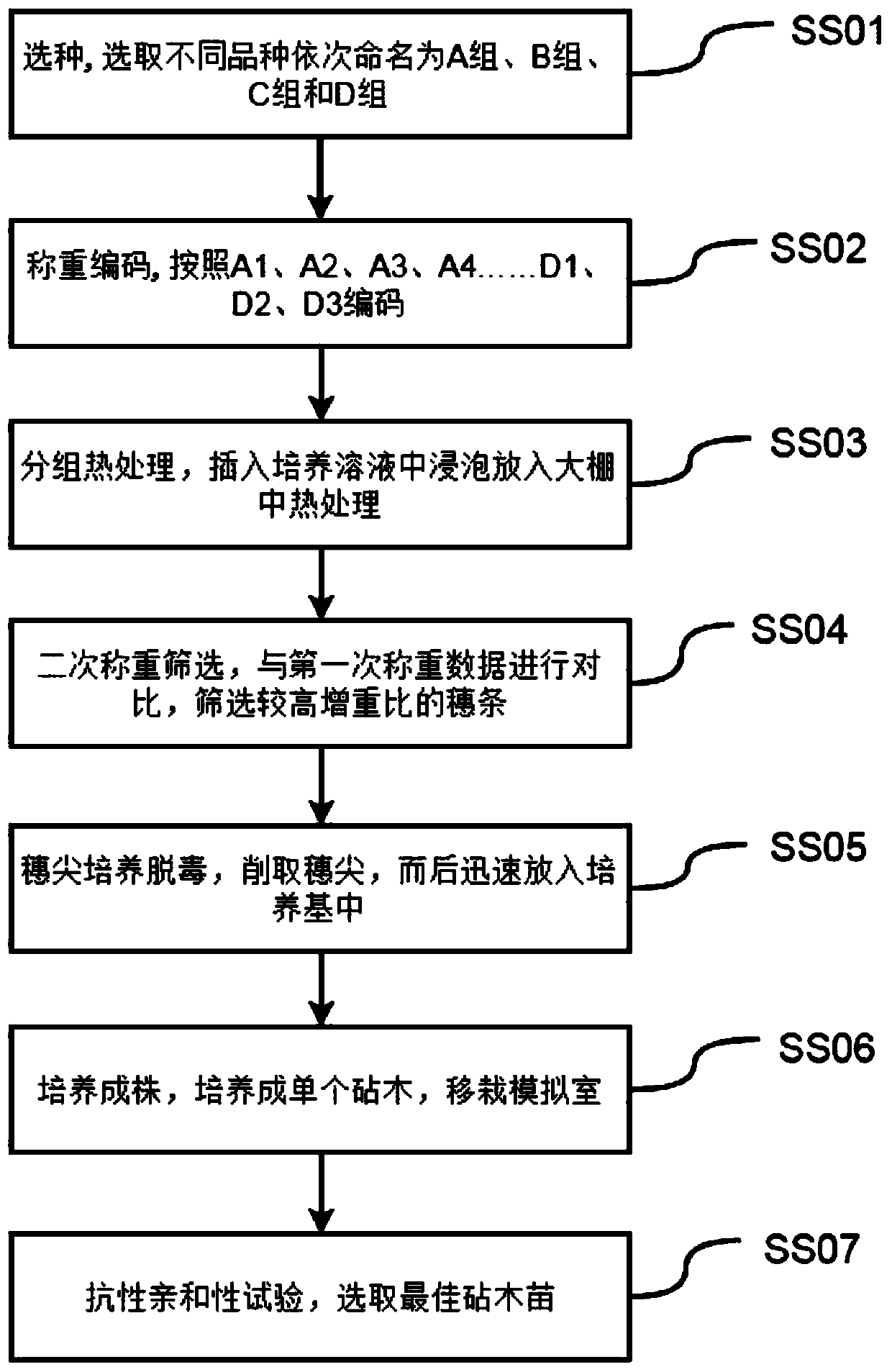Culture method of asexual cloned virus-free seedlings of sweet cherry rootstock
A cultivation method and technology for sweet cherries, applied in the field of plant tissue culture, can solve the problems of difficult planting of cherries, unstable affinity, harsh planting environment requirements, etc., and achieve the effects of improving yield, improving reliability and improving resistance.
- Summary
- Abstract
- Description
- Claims
- Application Information
AI Technical Summary
Problems solved by technology
Method used
Image
Examples
Embodiment 1
[0027] see figure 1 , the present invention provides a kind of technical scheme: a kind of culture method of sweet cherry rootstock asexual clone virus-free seedling, comprises the following steps:
[0028] Step 1: Seed selection, select Meizao, Black Pearl, Rabins and Molly as the training objects, cut off the 25 cm spikes at the end of the branches, cut the intercepted surface into a cone shape, and name them in turn as group A, group B, C group and D group, every group of spike quantity is 25;
[0029] Step 2: Weigh and encode, and encode each spike in Group A, Group B, Group C, and Group D, according to A1, A2, A3, A4...D1, D2, D3 and so on. After the encoding is completed, respectively Weigh each spike and record the weighing data;
[0030] Step 3: Heat treatment in groups, inserting each spike of Group A, Group B, Group C and Group D into the culture solution for soaking, and then placing them in a greenhouse at 35°C for heat treatment for 12 days;
[0031] Step 4: Se...
Embodiment 2
[0045] The present invention also provides a technical scheme: a method for cultivating asexually cloned virus-free seedlings of sweet cherry stock, comprising the following steps:
[0046] Step 1: Seed selection, select Meizao, Black Pearl, Rabins and Molly as the training objects, cut off the 25 cm spikes at the end of the branches, cut the intercepted surface into a cone shape, and name them in turn as group A, group B, C group and D group, every group of spike quantity is 27;
[0047]Step 2: Weigh and encode, and encode each spike in Group A, Group B, Group C, and Group D, according to A1, A2, A3, A4...D1, D2, D3 and so on. After the encoding is completed, respectively Weigh each spike and record the weighing data;
[0048] Step 3: Heat treatment in groups, inserting each spike of Group A, Group B, Group C and Group D into the culture solution for soaking, and then placing them in a greenhouse at 37°C for heat treatment for 13 days;
[0049] Step 4: Second weighing and s...
Embodiment 3
[0063] The present invention also provides a technical scheme: a method for cultivating asexually cloned virus-free seedlings of sweet cherry stock, comprising the following steps:
[0064] Step 1: Seed selection, select Meizao, Black Pearl, Rabins and Molly as the training objects, cut off the 25 cm spikes at the end of the branches, cut the intercepted surface into a cone shape, and name them in turn as group A, group B, C group and D group, every group of spike quantity is 28;
[0065] Step 2: Weigh and encode, and encode each spike in Group A, Group B, Group C, and Group D, according to A1, A2, A3, A4...D1, D2, D3 and so on. After the encoding is completed, respectively Weigh each spike and record the weighing data;
[0066] Step 3: Heat treatment in groups, inserting each spike of Group A, Group B, Group C and Group D into the culture solution for soaking, and then placing them in a greenhouse at 40°C for heat treatment for 13 days;
[0067] Step 4: Second weighing and ...
PUM
 Login to View More
Login to View More Abstract
Description
Claims
Application Information
 Login to View More
Login to View More - R&D Engineer
- R&D Manager
- IP Professional
- Industry Leading Data Capabilities
- Powerful AI technology
- Patent DNA Extraction
Browse by: Latest US Patents, China's latest patents, Technical Efficacy Thesaurus, Application Domain, Technology Topic, Popular Technical Reports.
© 2024 PatSnap. All rights reserved.Legal|Privacy policy|Modern Slavery Act Transparency Statement|Sitemap|About US| Contact US: help@patsnap.com








